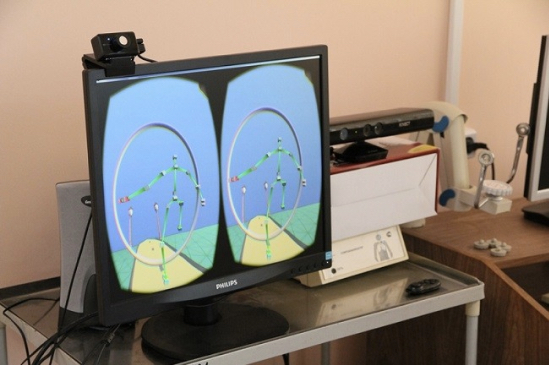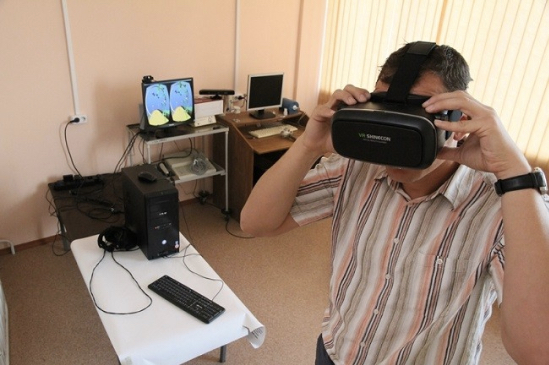Earlier Detection, Timely Treatment for MS, Parkinson’s Possible with Virtual Reality Tool
Written by |

 Scientists at Russia’s Tomsk Polytechnic University (TPU) and Siberian State Medical University (SSMU), both in Tomsk, have developed a diagnosis system for neurodegenerative diseases in the early stages. The system uses virtual reality (VR) technology to immerse a
Scientists at Russia’s Tomsk Polytechnic University (TPU) and Siberian State Medical University (SSMU), both in Tomsk, have developed a diagnosis system for neurodegenerative diseases in the early stages. The system uses virtual reality (VR) technology to immerse a  subject in a virtual environment during functional tests designed to detect early symptoms of diseases like multiple sclerosis, Parkinson’s disease, and others. The researchers change the virtual environment parameters and record results in the subject’s movements. The technical stage of the joint project is expected to be completed in 2017.
subject in a virtual environment during functional tests designed to detect early symptoms of diseases like multiple sclerosis, Parkinson’s disease, and others. The researchers change the virtual environment parameters and record results in the subject’s movements. The technical stage of the joint project is expected to be completed in 2017.
Ivan Tolmachov, senior instructor at the TPU Department of Industrial and Medical Electronics, associate professor at SSMU, explained in a press release that several systems, including the vestibular apparatus of the inner ear, determine a person’s position in space and direction of gravity. The muscular system and vision help people monitor the horizon.
“All these coordinated systems operate automatically. They falter if a person gets neurodegenerative diseases,” Tolmachov said.
A common feature of slowly progressive, hereditary or acquired neurodegenerative diseases like multiple sclerosis, Parkinson’s disease, and Alzheimer’s disease is a progressive loss of nerve cells (neurodegeneration) leading to various neurological symptoms, a major one being difficulty with coordination. The investigators note that in some Parkinson’s cases, the cell death process can begin around the age of 30 but symptoms of the disease may not begin until about age 50. Consequently, scientists worldwide are on the hunt for effective and affordable methods for diagnosing neurodegenerative diseases at early stages.
Typically, by the time a person can feel function loss, and certainly by the time a disease such as Parkinson’s is diagnosed, an estimated 60 to 80 percent of related cells are already lost.
“But then there is no way back to recovery. Therefore, it is so important to diagnosis the disease at early stages when (the) patient can get help. Currently physicians use definite tests to detect neurodegenerative diseases but they are mostly based on visual assessment and there is (a) lack of instrumental and effective methods. PET scanning (Positron Emission Tomography) is available only in nine cities in Russia,” Tolmachov said.
The experimental neurodegeneration detection and diagnosis system consists of augmented reality glasses, a contactless sensor controller and a mobile platform. It incorporates existing and relatively inexpensive devices such as Google Glass augmented glasses and Microsoft’s Kinect sensor system.

The diagnostic process has so far been tested on about 50 volunteers. Here’s how it works: the subject dons the VR glasses and enters a virtual reality where environment changes the slope, at which point a motion sensor detects changes of the subject’s body position at 20 points. A subject without neurodegenerative disorders will quickly adapt to the virtual reality and maintain a stable position, while a person with a disorder will encounter difficulty in adapting and will lose balance.
“We have integrated existing devices and developed mathematical models for data analysis. We have also created a human skeleton model, identified 20 important points that Kinect monitors. Diagnosis provides results of deviations in the 20 points,” said TPU scientist David Khachaturyan in the release.

“In the experiment, we tested how virtual reality influences people,” said Tolmachov. “The procedure took almost 10 minutes.”
The experiment engaged healthy people and those who had been previously diagnosed. Currently, the system does not say if a person is healthy and it does not make a diagnosis. However, the system can determine how the condition in a suspect subject differs from a healthy subject and it has determined how people with different diseases react to the virtual environment.
Completion of the technical phase of the project will likely take another year, after which the system will need to be tested in clinical trials and vetted for required technical and toxicological certification.
Tolmachov believes that the VR system could be used for patient rehabilitation, as well as disease diagnosis, in the future.





